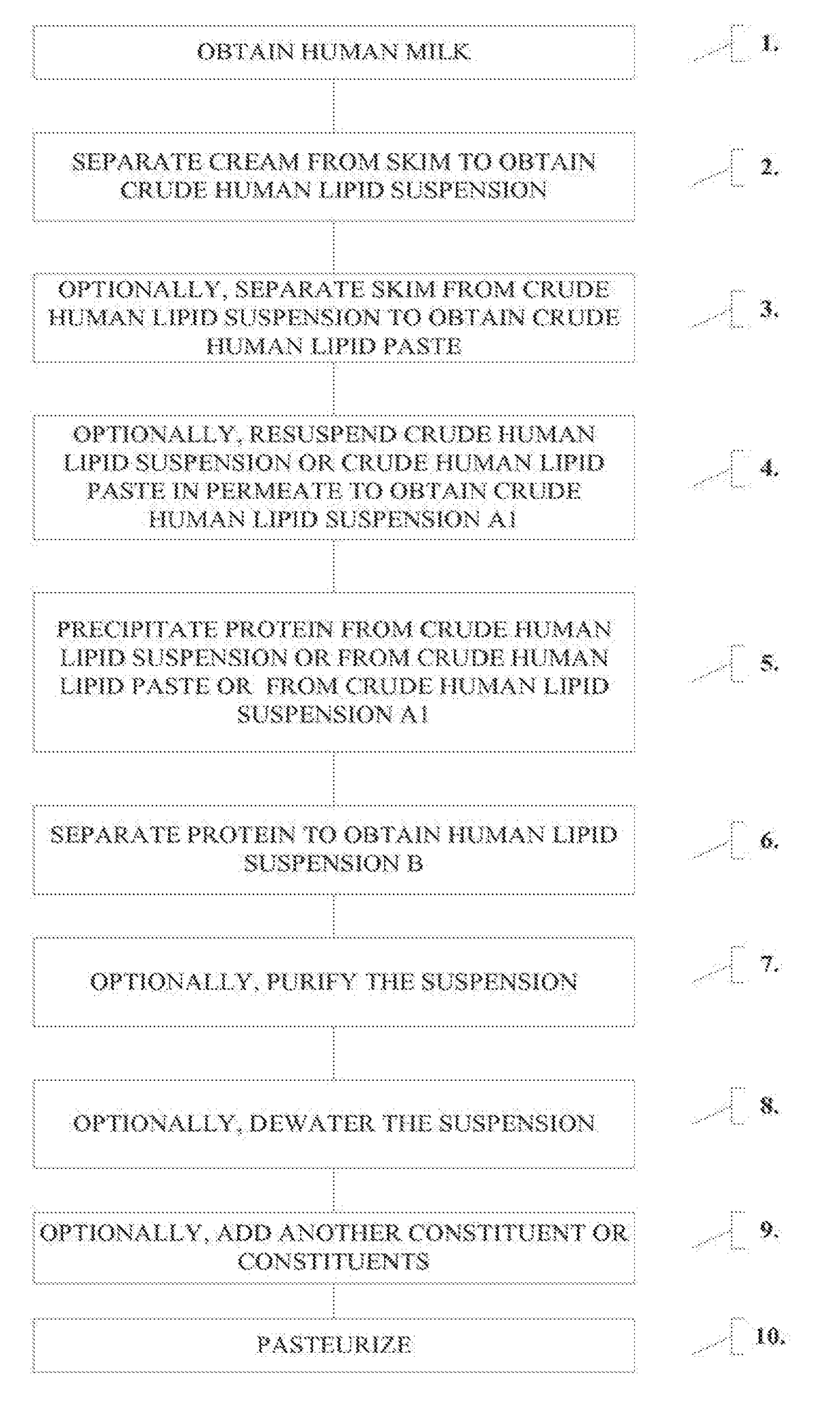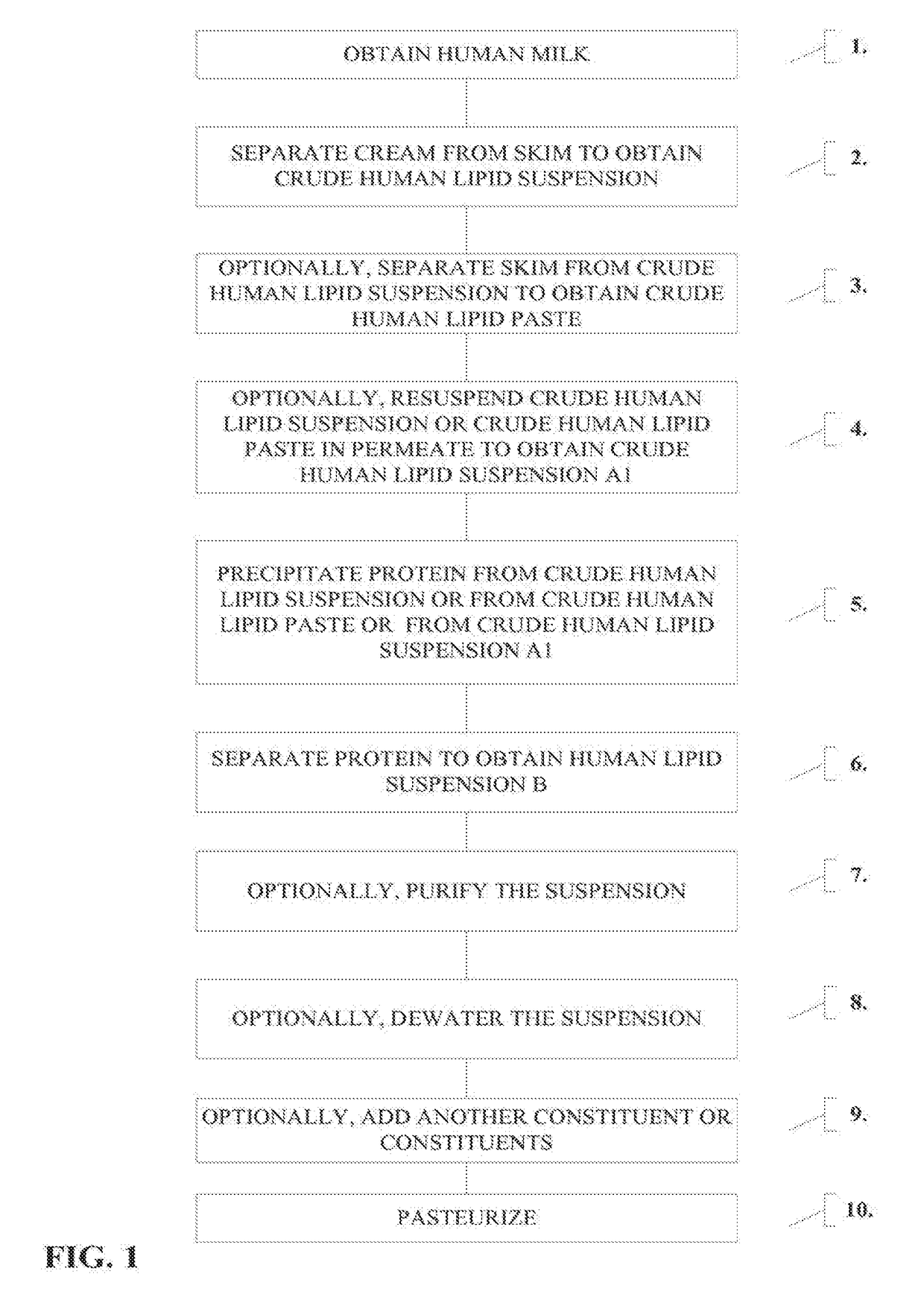Methods of preventing and treating bronchopulmonary dysplasia using high fat human milk products
a human milk product and bronchopulmonary dysplasia technology, applied in the field of high fat human milk products, can solve the problems of reducing bpd, causing growth failure and death, and causing bpd to only give transient benefits, and achieving the effects of reducing the duration and/or severity of bpd, preventing bpd, and low birth weigh
- Summary
- Abstract
- Description
- Claims
- Application Information
AI Technical Summary
Benefits of technology
Problems solved by technology
Method used
Image
Examples
example 1
Human Milk Cream Fortifier Product
[0099]In order to provide a nutritional supplement that can add the desired amounts of calories to mother's own or donor milk without adding a significant amount of volume, a human cream fortifier composition was produced that can be delivered enterally, thereby avoiding the negative effects associated with TPN. Human milk from previously screened and approved donors was mixed together to generate a pool of donor milk. In a clean room environment, the pool of donor milk was further tested for specific pathogens and bovine proteins. Specifically, PCR testing was used to screen for the presence of HIV-1, HBV, and HCV in the milk. A microbiological panel was also performed that tests for, e.g., aerobic count, Bacillius cereus, Escherichia coli, Salmonella, Pseudomonas, coliforms, Staphylococcus aureus, yeast and mold.
[0100]The pool of donor milk was ultracentrifuged to generate a cream portion and a skim milk portion. The cream portion was then formula...
example 2
Standardized High Fat Human Milk Compositions
[0103]In order to provide a standardized ready to feed formulation that can deliver a high level of calories without adding a significant amount of volume, high fat human milk human compositions are produced that can be delivered enterally, thereby avoiding the negative effects associated with TPN. Human milk from previously screened and approved donors is mixed together to generate a pool of donor milk. In a clean room environment, the pool of donor milk is further tested for specific pathogens and bovine proteins. Specifically, PCR testing is used to screen for the presence of HIV-1, HBV, and HCV in the milk. A microbiological panel is also performed that tests for, e.g., aerobic count, Bacillius cereus, Escherichia coli, Salmonella, Pseudomonas, coliforms, Staphylococcus aureus, yeast and mold.
[0104]FIG. 1 is a chart showing an embodiment of generating a human milk fortifier. The screened, pooled milk undergoes filtering, e.g., through...
example 3
Use of Human Milk Cream Product for Extremely Premature Infants Results in Shorter Length of Hospital Stay
[0111]In a multi-center trial, infants were fed an exclusive human milk diet according to the investigative site's standard feeding protocol. This diet included mother's own milk or pasteurized donor human milk fortified with pasteurized donor HM-derived fortifier, Prolact+H2MF (Prolacta Bioscience, Industry, California). After informed consent was obtained, infants were randomized into two groups via blocks for four, the size of which was blinded. Masking of the study groups was only able to be attained at one of the study sites due to logistical reasons.
[0112]Once the infants began tolerating fortified enteral feeds (at approximately 100 cc / kg / d), milk analysis with a near infrared milk analyzer (Spectrastar 2400RTW; Unity Scientific, Brookfield Conn.) began. The base milk supply of infants in the control group was not analyzed in accordance with the standard practice at the i...
PUM
 Login to View More
Login to View More Abstract
Description
Claims
Application Information
 Login to View More
Login to View More - R&D
- Intellectual Property
- Life Sciences
- Materials
- Tech Scout
- Unparalleled Data Quality
- Higher Quality Content
- 60% Fewer Hallucinations
Browse by: Latest US Patents, China's latest patents, Technical Efficacy Thesaurus, Application Domain, Technology Topic, Popular Technical Reports.
© 2025 PatSnap. All rights reserved.Legal|Privacy policy|Modern Slavery Act Transparency Statement|Sitemap|About US| Contact US: help@patsnap.com


